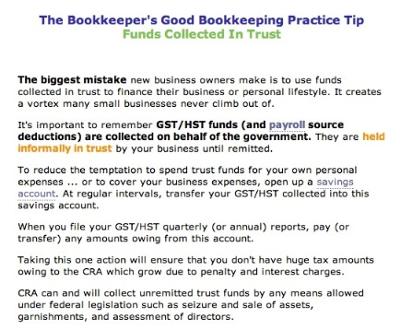Owners Draw and Personal Consumption
by Sherrill

Don't Make This Mistake With Funds Collected In Trust
Owners Draw - over extended - add personal interest?
Being year end I am wondering if I should calculate as a personal expense an interest calculation on an over extension of owners Draw (Sole Proprietor business).
On the income statement the Owner's Net income for the year is $10,000 and the owner withdrew $40,000 as Owners Draw. (FYI the Owners Capital is currently at -$6,000)
The owners business credit is maxed as well (So I'm wondering if the CRA in an audit would find issue with the owner withdrawing all funds from business for DRAW when he should be paying down the business credit cards)
I realize the interest on the business credit cards is a business expense but really that interest is inflated because the owner withdrew as a draw more than his income).
Whenever the owner withdrew funds from his business line of credit (as a draw) I calculated interest (same as the line of credit %) on that draw as personal interest until he put the funds back.
But these draws (totaling $30,000 are from his chequing account & over the course of the year - and he won't be paying it back). So I wonder if I should be doing the same as I do for the line of credit (charging interest on the draws over his net income per month over the last year)?
Should I journalize some interest as being personal with regard to the extra $30,000. owners draw? and if so at what interest rate (chequing acct rate or CRA prescribed rate?) Another option might be to set up a loan payable to the owner (but it sole proprietor business).
Help please (and Thanks)!

Hi Sherrill,
Unlike an incorporated business, a sole proprietorship is not a separate legal entity. There is no separation between the business and the owner.
This means, as you probably already know, that all the business income is taxed on their personal income tax return through Schedule T2125. Any business losses can be deducted from their other income.
It also means the owner is liable for any debt and/or liabilities incurred by the business. In other words, all of the owner's personal assets are at risk.
If the owner has overextended him/herself and removed "business" funds for personal living expenses, s/he is free to do so. It is their money. It would be a different story if the business were incorporated, as there are very specific rules about loans to shareholders.
You are absolutely correct to track and remove the "personal use" component of business expenses ... in your example, the business line of credit. The interest pertaining to
You didn't say specifically, but I am assuming when you calculated the personal interest component that you made an accounting entry to debit owner's draw and credit interest expense, thereby removing the personal use component.
Another concept, that can be confusing to some people, is that net income is not cash flow. The owner could have made a profit that will be taxable, but not have cash to pay the tax owing as s/he did not put any money aside to pay the tax when it is due April 30.
One of the biggest mistakes new business owners make is to spend GST/HST funds and/or payroll source deductions that were collected in trust for the government. It is a big deep hole that is hard to climb out of.
So the long and the short of it ... the owner is able to withdraw cash from the business chequing account as a draw with no immediate consequence. You do not calculate interest on these draws.
If the owner continues to do this, the business will eventually fail ... how quickly depends on the cash flow coming into the business and whether enough money has been allocated to pay the suppliers' invoices.
Hopefully, the owner has established pre-planned priorities for accounts payable payments, and adheres to it.
If this business is the owner's only source of income, the owner is living beyond his/her means. When you are doing the books, get paid in advance, and continue to remove the personal use component from any business related expenditures.
If government trust funds are being spent and the owner is on an annual filing basis and does not make instalments, recommend that the reporting period be switched to quarterly, so that funds are reported and remitted more frequently and ITCs claimed more regularly, increasing cash flow.
Try to get the owner to agree on a set draw that the business can handle ... like a pay cheque. This is difficult to do.
Remember Sherrill, try not to take ownership of the client's problems. All you can do is advise them on information/rules you know about and recommend a professional accountant for the rest.
I hope this helps. If I just confused you more, post back.
P.S. I would like to remind you there is a difference between information and advice. The general information provided in this post or on my site should not be construed as advice. You should not act or rely on this information without engaging professional advice specific to your situation prior to using this site content for any reason whatsoever.
Comments for Owners Draw and Personal Consumption
|
||
|
||
|
||
|
||
|
||
|
||